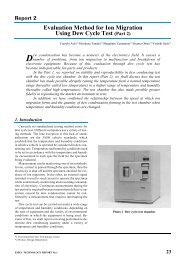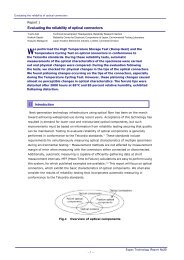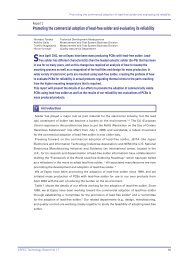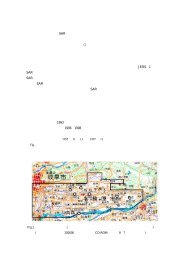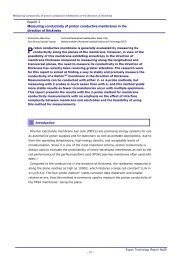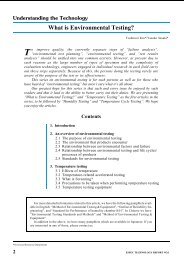download
download
download
You also want an ePaper? Increase the reach of your titles
YUMPU automatically turns print PDFs into web optimized ePapers that Google loves.
New product focus: Ultra View Temperature (& Humidity) Chamber<br />
2-2 Anti-fogging viewing window panes<br />
Environmental test chamber not only requires interior lighting and the effective visibility<br />
noted on the previous page, the chamber must also prevent the glass panes from fogging<br />
up due to the temperature and humidity conditions inside the chamber. Fogging occurs<br />
when the moisture in the air condenses on the surface of the glass. The conventional<br />
method of preventing fogging was to install a heater to warm the surface of the glass, but<br />
this approach required maintaining the glass surface temperature above the dew-point<br />
temperature, which was not economical. Also, during tests using such conditions as high<br />
temperature and low humidity, a heater is not required to maintain the glass surface<br />
temperature above the dew-point temperature. These new chambers prevent fogging on<br />
the glass surface using a heater control inside the glass, so instead of merely applying<br />
constant heat to the glass, only the minimum amount of heat required is used, thus<br />
conserving energy. (Patent pending)<br />
Glass using conventional heat-reflecting film or incorporating heating wires required the<br />
chamber design to incorporate upper and lower heat limits that were suited to the<br />
thermal limits of the glass panes. When reach-in ports were added to provide a means of<br />
operating the specimens, the glass surface in the vicinity of the reach-in ports tended to<br />
fog up, and localized hot spots occurred. This fogging was caused by not being able to<br />
place heaters near the reach-in ports (due to the processing on the glass for the ports) so<br />
that the heater current did not flow near the reach-in ports, resulting in a difference in<br />
current density in the vicinity of the reach-in ports. These new chambers are designed so<br />
that the current density is the same in all areas of the glass, including the areas around<br />
the reach-in ports, with no unevenness in current. Even when reach-in ports must be<br />
provided, there is no fogging on the surface of the glass, and the specimens can be clearly<br />
observed and operated. (Fig.1) (Patent pending)<br />
<br />
Fig.1 Current flow with viewing window reach-in ports in glass doors<br />
- 23 -<br />
Espec Technology Report No20



